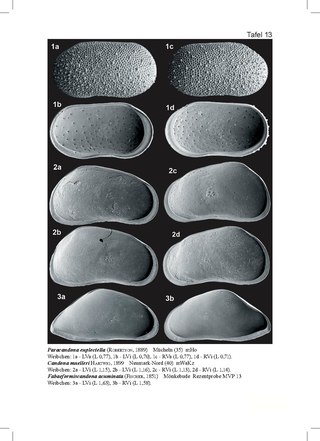
Zalophus is a genus of the family Otariidae of the order Carnivora.

Mirjana Karanović is a Serbian actress, film director and screenwriter. Considered one of the best Serbian and Yugoslavian actresses of all time, she is probably the best known for her performance in her debut film Petria's Wreath, as well as for her frequent collaborations with film directors Emir Kusturica and Jasmila Žbanić. Karanović received international acclaim and a nomination for European Film Award for Best Actress for her role in Žbanić's Grbavica.

Neritidae, common name the nerites, is a taxonomic family of small to medium-sized saltwater and freshwater snails which have a gill and a distinctive operculum. The family Neritidae includes marine genera such as Nerita, marine and freshwater genera such as Neritina, and freshwater and brackish water genera such as Theodoxus.

The Podocopa are a subclass of ostracods. Members of the subclass Podocopa can be differentiated from the other subclass of ostracods (Myodocopa) by the morphology of the second antenna: the Podocopa have a relatively long endopod, whereas the Myodocopa have a relatively long exopod. The seventh limb of the Podocopa has a variety of forms or is absent, but is never an annulated worm-like limb.
Metacyclops is a genus of copepod crustaceans in the family Cyclopidae, containing 61 species, of which three are listed on the IUCN Red List – M. campestris from Brazil, M. gasparoi from Italy (vulnerable) and M. postojnae from Slovenia (vulnerable).
Nitocrella is a genus of copepod. Although most other genera in the family Ameiridae are marine, species of Nitocrella are almost exclusively found in subterranean fresh water or brackish water. More than 80 species are included in the genus, including two which are listed as vulnerable species on the IUCN Red List:
Typhlocypris cavicola is a species of ostracod crustacean in the family Candonidae. It is endemic to Slovenia, where it is only known from Krka Cave.
Typhlocypris trigonella is a species of ostracod crustacean in the family Candonidae. It is endemic to Slovenia, where it is known only from Postojna Cave.

Cyclopidae is a family of copepods containing more than half of the 1,200 species in the order Cyclopoida in over 70 genera.

Notochelone is an extinct genus of sea turtle, which existed about 100 million years ago. The species was first described by Richard Owen in 1882 as Notochelys costata. It was renamed by Richard Lydekker in 1889. It was the most common marine reptile living in the inlands of the sea around Queensland, Australia. It was small turtle with carapace less than 1 metre (3.3 ft). Analytical studies have indicated that the creatures frequently ate benthic molluscs.

Enidae is a family of air-breathing land snails, terrestrial pulmonate gastropod mollusks.
Krausella is an extinct genus of ostracods. It is the sole genus in family Krausellidae.
Typhlocypris is a genus of ostracods, which are a small, bivalved crustaceans. It contains the following species:

Cyprididae is "the most diverse group of freshwater ostracods". It contains over 1000 species, which represents 50% of the known species of freshwater ostracods. Around 60% of genera in the family are endemic to a single zoogeographic region. The family contains 16 subfamilies, and is most diverse in the Afrotropical realm, with over 300 species in 45 genera. Many Cyprididae occur in temporary water bodies and have drought-resistant eggs, mixed/parthenogenetic reproduction and ability to swim. These biological attributes pre-adapt them to form successful radiations in these habitats. Bennelongia is an interesting of the family Cyprididae. It may be the last true descendant of the Mesozoic lineage of Cypridea, which was a dominant lineage of ostracod in non-marine waters in the Cretaceous.

Candonidae is a family of ostracods, containing around 25% of all known species of freshwater ostracods. Around 75% of genera in the family are endemic to a single zoogeographic region. It contains more than 500 species, of which more than 300 are endemic to the Palearctic realm.

Candona is a genus of ostracods in the family Candonidae.
Areacandona yuleae is a species of freshwater ostracod crustacean in the family Candonidae. It was originally described in 2007 from specimens collected from the Pilbara region in Western Australia, by Ivana Karanovic.
Candonopsis is a genus of ostracod in the family Candonidae. The genus has a cosmopolitan distribution.
Neocandona is a genus of ostracods belonging to the family Candonidae.

Ameiridae is a family of crustaceans belonging to the order Harpacticoida.










